
Official Edgar Rice Burroughs Tribute Site
Since 1996 ~ Over 15,000 Webpages in Archive
Volume 0012
ACADEMIA



BU Meet Your Professor Profile |
Canadian university and high school classrooms I often integrated ERB material into my courses -- especially in creative writing and science fiction projects. Almost any of the commonly used
I've devoted this edition of ERBzine to
Bill Hillman
|
Web introduction assignments can involve ERB-based scavenger hunts across the Internet. Students are given a list of items to find accompanied by clues: i.e. specific information in selected Websites, use of limiting keywords in search engines, finding and joining relevant listservs, collections of links & illustrations, current and historical events, bio info, items on eBay or online book sites, etc. This can involve a search across the entire Web or may be limited to a large Website such as ERBzine.Researchers who study the life and works of ERB is impressed by the many spinoff themes to which they are led. A perusal of the ERBzine Archive gives some idea of the diverse topics that come out of such an exercise. The ERB Connections series presents some of the more obvious references.
Exercises can be created in which key words are used to search ERB e-texts for specific information. ERBzine's internal Google search engine found at the bottom of the ERBzine index page may be used or once a Web page has been downloaded the browser's Search (CTRL-F) may be used. This is particulary useful when analyzing the ERB electronic texts at: ERBzine 0889 or in the huge list of classic texts found in the ERB e-text library of favourite authors
ERB material lends itself to Journal Writing or Weblog projects as the educator can examine the role that journal writing plays in Burroughs’ works -- a writing device that he makes excellent use of in many of his tales.
I have often used sample pages from ERBzine in my university classes to show how almost any topic may be adapted to Webzine, newsletter or Web page format.
An interesting source for grammar activities for all levels is the unauthorized book: Tarzan and Jane's Guide to Grammar: The World's First Grammar Novel by Mark Phillips published by A. J. Cornell Publications, NY.
Sandwich Paragraph Writing Activities Using ERB First and Last Sentences make for good creative writing exercises. The students finished paragraph may then be compared to the version originally created by Burroughs.
After reading selected ERB novels of strange lands (Pal-ul-don, Pellucidar, Caprona, Amtor, Barsoom, lost civilizations in Tarzan's Africa, etc.), students are be directed to write an outline or "treatment" describing an imaginary locale and to populate it with strange beings and creatures. The student may then expand this opening plan into a longer piece of imaginative writing.
As part of a film study and/or video production unit assign the reading of an ERB novel and/or distribute a summary of the story. Divide the class into groups and assign chapters to each group. This group is then responsible for adapting their chapters to a conventional film script.
Integrate the Burroughs phenomenon into studies of 20th century and modern media. Since ERB created new literary genres and was in the forefront or instigator of all the elements of 20th century media he presents an excellent case study. Concentrating on the Burroughs creations makes for an interesting and more wieldy approach to this otherwise sprawling and overwhelming topic.
I have used many more activities. . .
. . . someday when time permits I'll display them here at ERBzine
Some of the oter ERBzine features that
I've found useful for classroom integration include:
The ERB Tri-Via Game starting at ERBzine 0642: CONTENTS: ERB TRI-VIA PAGES
Tarzan the Ape Man: Video Log and Summary for the 1932 MGM Film in ERBzine 0642
The ERB Mars Trilogy Log Notes and Study Guides starting at ERBzine 1286
The Hillman Log Notes & Study Guide Series
ERB's Mars Trilogy ~ 1350 QA-NotesPrincess of Mars I
520 Visible AnswersPrincess of Mars II
520 Visible AnswersGods of Mars I
425 Visible Answers VersionGods of Mars II
425 Visible Answers VersionThe Warlord of Mars I
405 Visible AnswersThe Warlord of Mars II
405 isible Answers
The ERB Personal Library
A valuable source of biographical information,
electronic texts and other reference material
relating to 19th-21st century authors:
www.ERBzine.com/dan
More Web Ideas
ERB Electronic Text Editions
ERB Connections
The ERBzine Recommended Links Page Contains a Multitude of Reference Material
E-text Library of ERB's Favourite Authors
1. DO-IT-YOURSELF EDUCATION
Recent years have seen a big brouhaha over why Johnny can't read. Who remembers how Lord Greystoke learned to read. ... Long before he saw a fellow white man he had learned to read and write English better than some American high school students. ...In the cabin where his ill-fated parents had perished, ...(the ten-year-old) discovered books. Certain little "bugs" on the pages bothered and perplexed him. ... There were always a few hanging around under the pictures.... As he became used to the bugs his sharp observation recognized their individual shapes and he saw that there were only so many different ones, gathered together in various combinations.The irony is that Burroughs, the jungle romanticist, unconsciously developed the controversial and recently bitterly denounced recognition method of learning to read, which is based on recognition of letter groups and their association with accompanying pictures. Tarzan, like American school Johnnys of several generations, was innocent of phonetics. When he met white men he could not understand what they said though he could communicate effectively in writing.
Yet by his unaided efforts, young Tarzan discovered that he was M-A-N rather than A-P-E. His progress was painfully slow, but by 18, long since having passed from primer to other books and the dictionary, he could read and write English with admirable skill. ... Images were moving from the pages of books into his life, as they do for all the rest of us who come to reading in more conventional ways.
Tarzan's self-education consisted of making mental connections. So-called electronic brains are systems of circuits that link quantities of stored data. They "think" with these data within the limited scope of instructions given to the machine. The circuits and linkages of the human brain, in the small, frail housing of a skull, are infinitely greater than the largest bank of computers. The electronic brain does the human mind's drudgery only under instruction. The living mind instructs itself.
Tarzan's feat lay in recognizing relationships and patterns. From observation he advanced to conclusions; upon these he built generalizations; within these he noted particulars, and so around again. This is not only the way of learning to read, but the way of learning anything. This is how intelligence -- shared by animals -- becomes intellect, unique to man among earthly creatures. The very process of learning that he was M-A-N lifted Tarzan to the actual status of Man.
It is profoundly meaningful that Tarzan learned by himself. We are never really taught. Teachers, books, laboratories, schoolhouses, all are ultimately aids to help us learn, which we either can or can't, or will or won't do. Beware the larger mistake behind the common error of the uneducated: "He learned me." Nobody ever "learned" anybody; it's a do-it-yourself job. ---Edmund Fuller, excerpts from The Wall Street Journal, Oct. 29, 1963
2. Tarzan's Literary Merit
What is the literary merit of the Tarzan books? What is the vision of life and character that they offer? From a lofty view they are sub-literature. The giant purple cliche blooms in rank luxuriance in their pages like the other jungle growths. ... On the other hand, Burroughs' writing is syntactically impeccable, occasionally attains to eloquence, and is full of concepts, however sententious. ...Burroughs was a mass best-seller of his day... When it comes to forming the mind, which would you rather have in the picture, the Tarzan books, or the modern comic books, Spillane, and a growing host of shoddy irresponsibles exploiting the current anything-goes freedom from restraint in violence and perversion? The Tarzan stories seen in this perspective are among the most elevated and edifying books of mass-audience appeal now on the racks. ... (ERB) sees both man and beast as sometimes noble and ignoble. At any rate, nobility, in markedly short supply in current fiction, is the standard held up for emulation in Tarzan's world. ...
Classify these books as you wish, but if Tarzan should help form a few minds these days, we could do -- in fact we have long been doing -- much worse. --Edmund Fuller, excerpts from The Wall Street Journal, Nov. 5, 1963.
3. Excerpt: THE MAN WHO CREATED TARZAN by Edward T. Ewen, from "Eh-wa-au-wau-aoooow Tarzan," The New York Times... adopted by: SRA Reading Lab IIIa -- Lesson Card Tan 10 -- Copyright 1964, Science Research Associates, Inc.
This curious item is one of many examples of how the works of ERB have found their way into education curricula. The article, made up of a short bio and analysis of ERB's work, is reprinted in a booklet which is part of an SRA Reading Program for improving student reading and comprehension in schools.After timing his reading, the student turns to comprehension questions at the back of the booklet. This follow-up contains HOW WELL DID YOU READ and LEARN ABOUT WORDS Sections based on the ERB article. All answers and times are entered into a Record Book. Upon completion of reading and questions, the student corrects his responses with an answer card and graphs his results in the record book.
4. ERB's BASIC STORYTELLING FORMAT:
I. Introduction: A. Introduction of Main Character B. Transportation to another locale via ship, spacecraft, or supernatural means.II. Rising Action: A. Situation where main character seems helpless. B. Adoption or capture of main character. C. Swift rise to leadership or power among the new society.
III. Character Introduction: A. Main character meets woman in distress B. Main character and woman fall in love.
IV. Capture and/or Facing Certain Doom: A. Main characters face impossible obstacle or foe. B. Main Characters fight impossible odds and/or are captured.
V. The Escape: A. Main character and main female character escape from certain doom. B. Main characters cross wilderness or trackless wastes.
VI. The Loss: A. Main character loses female main character through capture or misunderstanding. B. Main character perseveres and regains companionship of female character.
VII. The Battle: A. Main character is forced into battle with the main forces of evil. B. Main character, through victory, saves the planet, country, city, or society.
VIII. Conclusion: A. Main character is reunited with or weds female main character. B. Main character is praised or rewarded for his triumphs over conflicting forces.
The use of this "master" plan with little deviation, except in characters or specific setting, shows how Burroughs followed a classical formula. As he changed the specifics of the characters and setting, he was building a new story along a "tried and true" set of blueprints.
---Adapted from: From Africa to Mars: The Political, Moral, and Social Commentaries of Edgar Rice Burroughs by Robert P. Greer -- Website and Masters Thesis
5. ODDS & SODS
Literature for Compositionby Kreuzer & Cogan, 1965, Holt Rhinehart & Winston, Inc. is a textbook for use in the study of English Composition. On Pages 261, 262, and 263 are the first 18 paragraphs of Tarzan of the Apes. On Page 267 is an assignment requiring the student to write an analysis of excerpts from H.G. Wells and Edgar Rice Burroughs. At last, we have an American textbook wherein ERB finally appears with all the great names of English Literature.
-- Hulbert Burroughs letter to Caz’s ERB-dom #13, April, 1965.
ERB "Clearly a writer for all ages."...Or more precisely put, a writer who understood all ages. Nothwithstanding the advances of modern civilization, we remain the same unruly and emotionally driven barbarians as ever put torch to Carthage, Rome, Dresden or Bosnia. The world may change, but people do not--and if they ever should literature will be thrown for a loop! Few writers capture that timeless premise that people interacting with people IS the real world, not the trappings which surround them. This is one reason I admire writers like Heinlein, Norton, Asimov and Clark, and the best of their imitators--all of whom owe something to ERB for putting to paper the foibles of mankind rather than acclamation of transient artifacts. --Bruce Bozarth
ERB's classical background, his understanding and apparent enjoyment of the older tales of mankind, shows in his works. His themes are simple and direct and his characters are strongly, sometimes starkly, drawn. The action of the tale tells what little morality there is: honor, self, love for another. Shakespeare and Homer, among few others, knew the values needed to hold an audience from beginning to end: tell a tale of real people, regardless of how unrealistic the situation, and the people will be entertained. Like Shakespeare, ERB tried his hand at all modes of story, the adventure, the mysterious, the humorous and tragic, though few of his tales truly bordered on the tragic. -- Tangor
6. Tarzan Swings Again, This Time For College Credit At ECU!
College Credit Courses Are Available At Eastern Caribbean University
http://www.freeyellow.com/members/theclassics/index.html
English 39901 Tarzan Novels
English 39902 Tarzan Movie Scripts
Geography 39003 Tarzan Locations
Marketing 39004 Tarzan Films Marketing Worldwide
Theater Arts 39005 Different Tarzan Actors
Theater Arts 39007 Independent Study
(Up to 12 semester hours)
HUMANITIES CORE COURSE
Reading Questions Based on Tarzan of the Apes1. What are the circumstances of the narrator learning about the legend of Tarzan? ...How do these circumstances influence or support the credibility of the legend (pp.15-16)?
2. What is the reason for their trip to Africa? Is this strand of the story pursued (pp. 15-16)?
3. In the chapter "The White Ape" (pp. 51-58) consider how Tarzan compares himself to the other apes. In what ways is the reader meant to trust or distrust his evaluations at this point?
4. Evaluate the first description of Africans in the text (pp. 84-87). How do these descriptions compare to descriptions of characters and communities already introduced?
Whom do they resemble and from whom do they differ most markedly?
What is the outcome or significance of Tarzan's first encounter with the Africans?
"Tarzan looked with wonder upon the strange creature beneath him--so like him in form and yet so different in face and color. His books had portrayed the negro, but how different had been the dull, dead print to this sleek and hideous thing of ebony, pulsing with life" (p. 90).
What is the significance of this detail that lifeless print cannot adequately convey the difference(s) with which Tarzan is confronted?
With these issues in mind, consider the description of the African village (pp. 102-106).
5. What is the outcome of Tarzan's first view of "other white men" (pp. 125-127)
What details mark the differences between Jane (Miss Porter) and Esmeralda?
Similarly, what details mark the differences between Esmeralda and the Africans native to the continent?
What are the differences between Tarzan and his cousin Clayton?
6. Once Tarzan saves Jane from Terkoz, how does their encounter together transform Tarzan?
What is the "true" nature of Tarzan (pp. 184-207)?
7. When Tarzan and D'Arnot discuss fingerprints near the conclusion of the text Tarzan asks "Do fingerprints show racial characteristics" (p. 263)?
What are the racial characteristics to which he refers? What is the "height of civilization" that the title of this chapter refers to?
Discussion Questions
1. Characterize Tarzan's parents, especially in comparison to the other characters aboard the Fuwalda, as well as those that surround them after their desertion.
What types of details establish their "nobility" of character?
2. A clear hierarchy exists among the various groups and individuals introduced in the narrative.
Sketch this hierarchy.
3. How is Tarzan characterized in relation to the community of apes in which he grows up?
Once Tarzan enters the cabin built by his parents, how does he change?
How does he acquire literacy?
What is the significance of this event?
How do these passages reveal what might be called the "unique excellence" of Tarzan?
4. What is Tarzan's great task once he arrives in America? How do his heroic actions differ from those he performs in Africa?
How are they similar?
Compare Tarzan to Canler, his rival for Jane Porter. What is the point of providing Tarzan with adventures in "civilization"?
5. In what ways are Tarzan's developmental trajectory and sense of conscience ultimately reminiscent of the positions of Augustine or Descartes? In what ways are they different?
7. THE READING LEVEL OF THE TARZAN NOVELS
Based on the original research done by Robert Gunning and Patrick DearenAs a writing style guideline for journalists, Robert Gunning developed what he coined as a "fog index" to determine the readability of prose. Gunning found that the longer the sentences and more complex the words, the more difficult a story is to read. Modern journalism generally follows a simple style - most newspapers are written around a grade eight level. He based his formula on the average length of a sentence and the percentage of three-or-more syllable words. Applying this readability study to ERB we can determine a step-by-step progression of his writing style over his 35 year career - but more importantly it might be a way to determine the authenticity of dubious works such as John Carter and the Giant of Mars and the Tarzan Red Star/Forbidden City work. The "fog indexes" for the Tarzan novels are presented here and are open to many interesting interpretations when collated with the information from his Career Timeline which I have created at:
http://www.erbzine.com/bio/
|
|
|
|
| Tarzan of the Apes |
|
|
| The Return of Tarzan |
|
|
| The Beasts of Tarzan |
|
|
| The Son of Tarzan |
|
|
| Tarzan and the Jewels of Opar |
|
|
| Jungle Tales of Tarzan |
|
|
| Tarzan the Untamed |
|
|
| Tarzan the Terrible |
|
|
| Tarzan and the Golden Lion |
|
|
| Tarzan and the Ant Men |
|
|
| Tarzan, Lord of the Jungle |
|
|
| Tarzan at the Earth's Core |
|
|
| Tarzan the Invincible |
|
|
| Tarzan Triumphant |
|
|
| Tarzan and the Leopard Men |
|
|
| Tarzan and the City of Gold |
|
|
| Tarzan and the Lion Man |
|
|
| Tarzan's Quest |
|
|
| Tarzan and the Forbidden City |
|
|
| Tarzan the Magnificent |
|
|
| Tarzan and the Champion |
|
|
| Tarzan and the Madman |
|
|
| Tarzan and the Castaways |
|
|
| Tarzan and "The Foreign Legion" |
|
|
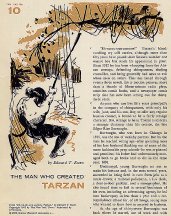
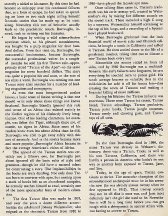
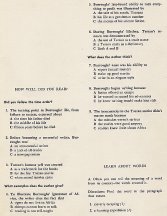
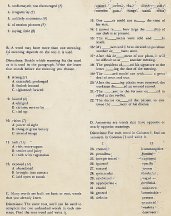

|
Guide to Grammar by Mark Phillips A. A Love Story
Romance!
|
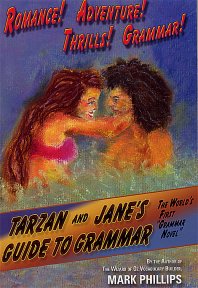 |
The World's First "Grammar Novel" THE PREMISE: Jane, a young American journalist, has been sent to Africa to write a series of articles about Tarzan's unusual life. She convinces the ape-man to write the articles himself, but first she must each him everything about grammar so that he can write at a level suitable for publication! Join Tarzan and Jane in their romantic, exciting adventures and listen in as Jane teaches Tarzan all about the parts of speech, phrases and clauses, punctuation, and much, much more. You'll never have a better time learning about grammar. |
11. TARZAN® LESSON PLAN FROM THE NEW ZEALAND MINISTRY OF EDUCATION
Kia ora, welcome to Te Kete Ipurangi The Online Learning Centre. TKI is a bilingual portal-plus web community which provides quality assured educational material for teachers, school managers, and the wider education community. It is an initiative of the Ministry of Education.CREATIVE PLAY
Years 1-3 ~ Key Area of Learning: Physical Activity
Health and Physical Education
CURRICULUM IN ACTION
Possible learning experiences
In search of Tarzan
Suggested learning outcomes
Students will:Underlying concepts: Attitudes and valuesdevelop a range of movements in order to express themselves (1B1); say what they enjoyed about taking part in an imaginative activity (1B2).
Learning and developing positive attitudes towards exploring movement.Possible learning activities
To motivate the students:Introduce an imaginative story activity by telling your students: "We're going on an adventure in search of Tarzan, King of the Jungle." Ask the students to develop and elaborate on the story using brainstorming, discussion, and movement. As the students develop the story step by step, discuss the following aspects.use forest or jungle noises from music or film soundtracks; read a jungle story. The students can brainstorm a journey as a group and then physically move through their created adventure with a partner.What might the jungle be like? What could we see (under, over, between, through, and past things), hear (bird and animal sounds, leaves rustling, water dripping), feel (textures of the ground, slime, water, rocks, bark), and smell? How might we move through the jungle to find Tarzan (by crossing, stretching, crawling, reaching, pulling, pushing, holding, swinging, slipping, falling, sliding, tripping, marching, twisting, squeezing, dodging, jumping, running, and walking over, through, under, and around mountains, caves, rivers, treetops, rocks, and cliffs)? What will we take with us on our journey? How will we take it? Where will Tarzan be in the jungle? How can we reach him? What could we do to look after our partner when on our journey? How do we take care not to damage the jungle?
After completing their journey, the students can describe what they did and what made this an enjoyable activity for them (1B2).Variations and extensions to this activity could include the following:
Assessment opportunity: Students state what they enjoyed about moving in an imagined environment (1B2).Replace Tarzan with Xena or with a taniwha, w?t?, or kiwi. The students could consider different ways of moving in different environments with their own kinds of obstacles to encounter. Teachers' notes: This activity requires an environment with space to move in, which may include obstacles, lines, playground apparatus, and other equipment.
Movement skills: This activity encourages the students to explore movements such as crawling, twisting, dodging, and swaying.
![]()
From

ERBzine.com
The
Fantastic Worlds of Edgar Rice Burroughs
ERB
Companion Sites Created by Bill Hillman


![]()

![]()
BILL
HILLMAN
Visit
our thousands of other sites at:
BILL
& SUE-ON HILLMAN ECLECTIC STUDIO
ERB
Text, ERB Images and Tarzan® are ©Edgar Rice Burroughs, Inc.-
All Rights Reserved.
All
Original Work ©1996-2006/2009/2019 by Bill Hillman and/or Contributing
Authors/Owners
No
part of this web site may be reproduced without permission from the respective
owners.